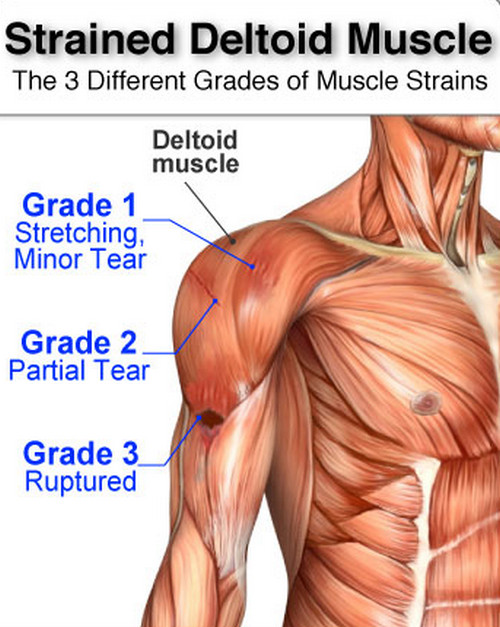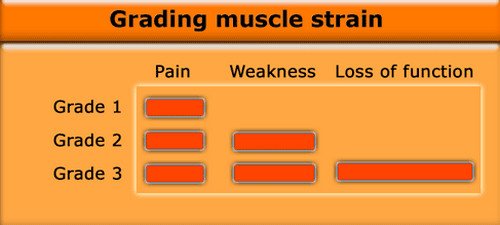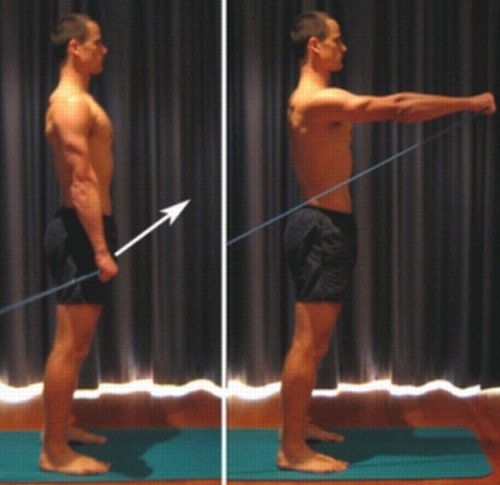Deltoid Pain
What is the deltoid muscle?
It is a triangular rounded muscles situated on the top most part of the arms and shoulders.
It is also called deltoideus muscle. Deltoid muscles cover the shoulder joints. It is derived from the Greek letter delta, which has an equilateral triangle shape. The deltoid muscle is attached by the tendons to the skeleton at the collar bone (clavicle), shoulder blade (scapula), and upper arm bone (humerus).
The deltoid consists of three divisions of muscles. They are as follows:
- Anterior deltoid – It is located on the front part of the shoulder above the chest muscles.
- Middle deltoid – It is located outside the shoulder area.
- Posterior deltoid – it is located at the backside of the shoulder joint. (2, 3, 4)

Image 1: The anatomy of the deltoid muscle outlining the three muscle divisions: anterior, middle, and posterior.
Picture Source: www.musclesused.com

Photo 2: The three different grades of muscle strain
Image Source: www.aidmymuscle.com

Picture 3: Muscle strain grading and their corresponding symptoms.
Photo Source: www.radiologyassistant.nl
 Photo 4: Deltoid muscle exercise using a resistance band.
Photo 4: Deltoid muscle exercise using a resistance band.
Image Source: www.physioadvisor.com
What are the functions of the deltoid muscles?
The deltoid muscle is the one responsible in moving and stabilizing the shoulder joint. It is the most important abductor muscle of the shoulder joint. It abducts and extends the arm at the shoulder joint. It also flexes and rotates the arms at the shoulder joint. (4)
Deltoid muscle pain causes
The deltoid muscle is prone to pain. Why does my deltoid muscle hurt? What could possibly be the causes of deltoid pain? One of the reasons for deltoid pain is strain. Overuse and abuse of the shoulder can trigger deltoid muscle pain. It could cause damage to the muscle fibers. It also causes inflammation of the tendons in the deltoid region (tendonitis). Deltoid tendonitis symptom include muscle stiffness, swelling and bruising in the deltoid area, pain and inflammation even when the muscle is at rest, limited range of motion, muscle weakness, and muscle loss. The severity of deltoid muscle pain symptoms are determined using the deltoid muscle strain grading.
- Grade 1 – It is a minor tear wherein only 10% of the muscle fiber is affected. The pain is minor but can be triggered by movement and adding weight in the arms. The recovery period is 7 to 10 days.
- Grade 2 – There is a partial tearing of the deltoid muscle wherein more than 50% of the muscle fiber is affected. The patient complains of a sharp pain in the shoulder area. The pain is triggered by simply lifting of the arm or even carrying a bag of groceries. Pressing a finger into the deltoid muscle will produce pain. It usually takes four to six weeks for the muscles to completely heal.
- Grade 3 – More than 90% of the deltoid muscle is affected. The pain is severe with obvious bruising and swelling of the shoulders. The patient cannot move his arms because even the slightest flexion of the muscle will produce pain. It may take three to four months for the deltoid muscles to completely recover. (5, 6, 7, 8)
Activities/factors that can further increase the possibility of deltoid pain
- Sports – sports that primarily used the deltoid muscles can increase the possibility of deltoid pain. Examples are weightlifting, skiing, and swimming. Carrying a small children for a long period of time and working with heavy tools can strain the deltoid muscles leading to deltoid pain.
- Injury – A sudden sharp blow to the shoulder area can cause pain in the deltoid muscle.
- Damage to the axillary nerve – What is the axillary nerve? It is the tight bundle of nerves near the neck. Its goal is to stimulate the deltoid muscles to take actions when you are using your arms and shoulders. Damage to the axillary nerve can affect the proper functioning of the deltoid muscles. It could lead to numbness and weakness of the shoulders. There are various reasons why the axillary nerve can get damaged such as direct injury, infection, improper use of crutches, fracture, and shoulder dislocation. (9, 10)
- Trigger points – They can cause pain in the deltoid area, but the actual source of pain is somewhere else. The deltoid area has trigger points too and they can be activated by repetitive use of the shoulders. The deltoid muscle is located in the shoulder region. If you feel pain in the shoulder area, it is a must to properly diagnose the condition because of the proximity of the shoulder to other important organs in the body such as the lungs and heart. (3, 4)
Differentiating muscle strain and sprain
A strain pertains to injury of the muscles and tendon units. On the other hand, sprain pertains to injuries to the ligaments. The deltoid is a muscle, which means that it can be strained but not sprained.
Diagnosis
To accurately diagnose the condition of the patient, the doctor will perform a thorough physical examination. The doctor will assess the extent of the pain. He will assess the strength of the deltoid muscles including the range of motion. If the doctor is suspecting a fracture or dislocation, a radiograph procedure is needed. (5, 7)
Deltoid muscle pain treatment
How do you heal a torn shoulder muscle? What is the most effective deltoid pain relief? Health professionals used a conservative approach in treating deltoid pain. Mild deltoid pain should be put to rest, cold compress, and elevated.
Patients who complain of severe pain require pain reliever such as non-steroidal anti-inflammatory medication. NSAIDs can help reduce the pain and inflammation. There are also over the counter cooling gels which give temporary pain relief.
They are effective in preventing swelling and inflammation. For stiffness and mild pain, a warm compress can help improve the condition. Hence, an alternate cold and warm compress can improve the overall condition of the patient. (3, 4, 7, 8)
Deltoid pain exercises
A significant part of the deltoid pain treatment is exercise. There are various forms of exercises for deltoid pain. Some of them are the following:
- Static deltoid contraction – Stand next to the wall with your back and elbow straight. Slowly push your arm to the side and position against the wall as hard as you can. Hold for a few seconds and repeat 10 times as long as there is no pain.
- Deltoid exercise using resistance band – Stand with your back straight and hold a resistance band. Slowly raise your arm at the shoulder level making sure that your arm and back are straight and slowly lower back down. (4, 6)
- Range of motion exercise – This is done to restore the flexibility and range of motion ability of the shoulders. Examples of range of motion exercise is arm circles and scissor exercise. (1, 8)
Make sure that you consult your doctor before starting any forms of exercise, especially if you are suffering from severe deltoid pain. If you do it wrong, then you can cause further harm to the muscles. The recovery time for deltoid pain may take time.
Mild deltoid pain can be relieved after a few days or weeks. Those with severe deltoid pain may take a few months to completely heal.
References:
- https://www.livestrong.com/article/487197-deltoid-injury-rehabilitation-at-home/
- http://www.sportsinjuryclinic.net/sport-injuries/shoulder-pain/deltoid-muscle-strain
- https://www.belmarrahealth.com/deltoid-muscle-pain-symptoms-causes-pain-relief-tips/
- http://www.aidmymuscle.com/shoulder/deltoid-strain.php
- https://www.muscle-joint-pain.com/trigger-points/trigger-point-self-treatment/deltoid/
- http://thewellnessdigest.com/deltoid-muscles-shoulder-pain-and-weakness/
- http://www.sportsmd.com/sports-injuries/shoulder-injuries/deltoid-strain/
- https://www.livestrong.com/article/476219-rehab-for-a-deltoid-injury/
- https://www.menshealth.com/fitness/deltoid-muscle-strain-front
- https://www.emedicinehealth.com/rotator_cuff_injury/page3_em.htm
Published by Dr. Jackie Te RN, MD under Pain Management.
Article was last reviewed on January 12th, 2022.

